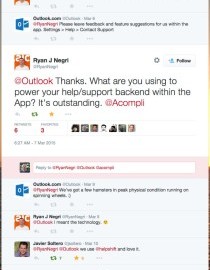Are you hoping to bring your enterprise into a $ 77 billion mobile app market? Enterprise companies navigating into the small screen will find their legacy IT won’t allow them to meet customer needs fast enough. According to Gartner, market demand for apps will grow at least 5x faster than IT organizations’ ability to deliver in 2017. Startups will nab your mobile app’s market-fit faster than you can schedule the next executive meeting.
Thus, enterprises are often forced to either open up the pocketbook for an acquisition or deal with a competitor one step ahead of them. What if there’s a better way? This article shows how enterprises can successfully launch mobile apps at the pace of smaller businesses.
1. Rediscover Strategic Intelligence
“Organizations increasingly find it difficult to be proactive against competitive pressures, which is resulting in their mobile apps becoming tactical, rather than strategic.” – Adrian Loew, Gartner
First we need to define two types of business intelligence: tactical and strategic.
Tactical intelligence deals with implementation. It evaluates current market conditions and uses available resources efficiently to accomplish goals. Enterprises find their strength here because they naturally have more finances and manpower to achieve desired results. ex. “How do I achieve today’s objective?”
Strategic intelligence is about planning the next move in a business. It involves visualizing the future of a product by recognizing emerging trends in the marketplace. Strategic intelligence is a trait that startups inherently have–disrupting the market by getting ahead of customer desires. Enterprises struggle with strategic intelligence and are generally reactive toward new trends. ex. “How do I plan for tomorrow’s opportunities?”
For an enterprise company to keep up with mobile consumer demand, it’s important that they enable themselves to be more strategic while retaining their tactical strength. The majority of enterprises achieve this by using modern mobile-first CRM software to create efficient feedback loops for their apps.
2. Create a dedicated mobile development team
Most companies currently need 7 months to a year in order to build one app, and the process can cost anywhere between $ 500,000 to $ 1,000,000. Those figures become more daunting when you multiply it by the number of operating systems you want to support. A huge reason for those costs is because enterprises often get fragmented; 71% of app development is led by individual departments rather than a single centralized approach.
Create an agile team including developers, product managers, and support agents that are explicitly assigned to your mobile app’s development. Give them the autonomy to move fast on front-end features. Provide them the tools to engage with customers directly to form a great feedback loop. Customer retention (and user experience) will rise when developers can move at the tempo customers expect.
3. Take a hard look at your software
Many businesses use legacy software and IT infrastructure that no longer fits mobile customer expectations–native, on-demand, and seamless. They have to transition toward modern options that startups are able to adopt from the start. Take a moment to examine the software in your IT infrastructure. Do you have all the right tools to succeed?
Some questions to consider about your software:
- Is your mobile solution designed for web support, or built with mobile in mind?
- Does your mobile solution take users out of the app, leverage a mobile web page, or require users’ email?
- Has your solution been proven to scale by other enterprises?
Everyone knows by now that a robust CRM solution for your mobile app is mandatory. Replacing email support with native messaging is simply a better experience for all involved, especially when enhanced with push notifications. An amazing knowledge base should also be included in that package to keep support costs lean–a self-service option that customers want to use will save a company hundreds of thousands. Bonus points if your mobile knowledge base supports web as well (but is not 100% web reliant). And of course, you won’t get the full picture of what customers are saying without good customer analytics features.
4. Give customer support a direct line to your developers
 Enterprises often struggle to address customer concerns in a timely way, leaving them vulnerable to churn, bad app store reviews, and agile competitors. Your product won’t be considered amazing if it takes 3 months to provide basic UX tweaks that customers ask for. For Microsoft Outlook, Kevin Henrikson (Partner Director of Engineering) used this strategy to succeed:
Enterprises often struggle to address customer concerns in a timely way, leaving them vulnerable to churn, bad app store reviews, and agile competitors. Your product won’t be considered amazing if it takes 3 months to provide basic UX tweaks that customers ask for. For Microsoft Outlook, Kevin Henrikson (Partner Director of Engineering) used this strategy to succeed:
“On a weekly basis we [Engineering] get a summary of the tickets that have been opened and processed throughout the week. We analyze the incoming feedback to see the hotspots of things we should look at in the build. Helpshift gives us the “Top 5 things we should be looking at this week.” We address the biggest concerns of our userbase for both existing users and new users. It could be a set of bugs, or something else particularly troubling. With that knowledge, we can dig in fast and provide fixes.”
Simply put–Microsoft acquired this method for $ 200 million because it works. When the end user has direct access to customer support, and support has the same direct relationship with your developers, app iterations become insanely more productive. Customers are delighted that change happens fast. And losing those customers to the competition is far less of a threat.
Enterprises don’t have to move slowly. When a large company picks the right tools and strategies, startup-like forethought and enterprise execution will make an unstoppable product.
(217)






